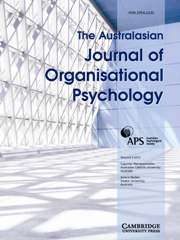Article contents
Prevalence and Organisational Factors of Psychological Injury Among Australian School Teachers
Published online by Cambridge University Press: 21 July 2014
Abstract
In this study, we investigated the prevalence, severity, and organisational factors of risk for psychological injury in a national sample of Australian school teachers, using the Psychological Injury Risk Indicator. We predicted that teachers would report higher levels of risk for psychological injury if working in schools located in rural areas, with a low socioeconomic index, and low psychosocial safety climate. Teachers from across Australia (N = 960) completed an online survey that measured risk for psychological injury and relevant organisational factors. We found a high number of teachers (26%) whose responses showed high risk, indicating the need for professional intervention in order to avoid potentially debilitating psychological injury. Analyses also showed main effects for two organisational factors, indicating that teachers most at risk for psychological injury tended to be employed by schools with low psychosocial safety climate and in areas with a low socioeconomic index. These results highlight the severe levels of work-related psychological injury risk in the Australian teacher population, and the important role for school administration and education departments in maintaining a working environment that supports staff psychologically.
- Type
- Articles
- Information
- Copyright
- Copyright © The Authors 2014
References
- 12
- Cited by




